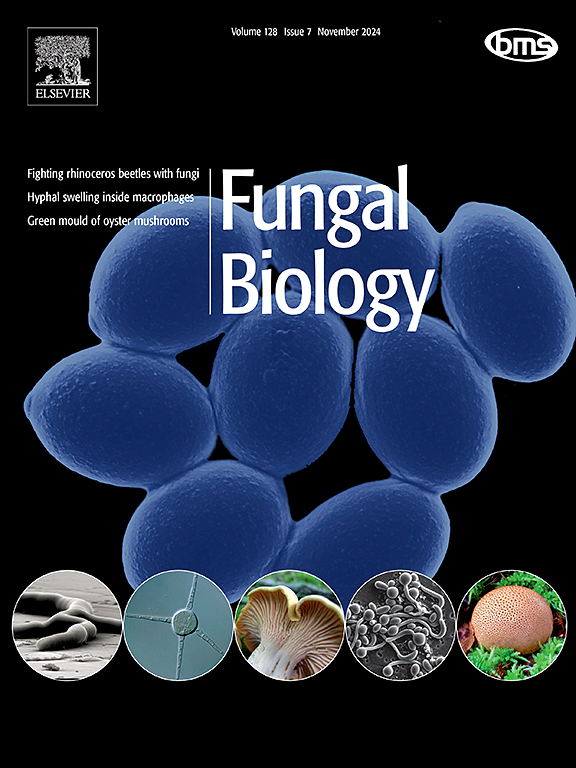Moh1 coordinates ROS-dependent apoptosis in genotoxic stress response of Candida albicans
IF 3
3区 生物学
Q2 MYCOLOGY
引用次数: 0
Abstract
Candida albicans employs apoptosis to maintain genomic stability under genotoxic stress, yet its regulatory mechanisms remain poorly defined. Here, we characterize the role of a putative pro-apoptotic factor Moh1 in C. albicans. Our findings reveal that MOH1 transcription is significantly upregulated under genotoxic stress and in DNA repair-deficient backgrounds (e.g., rad52Δ). Paradoxically, MOH1 deletion enhances resistance to genotoxic agents, improving cellular survival and reducing apoptosis, as evidenced by decreased nuclear condensation. Mechanistically, moh1Δ cells exhibit reduced intracellular reactive oxygen species (ROS), and pharmacological ROS scavenging with N-acetylcysteine abolishes the stress-resistant phenotype. Genetic interaction analysis identifies potential functional overlap between MOH1 and NMA111, a previously characterized pro-apoptotic factor. Transcriptomic profiling of moh1Δ cells under genotoxic stress shows dysregulation of DNA repair (SPO11, RFC52) and apoptosis (Orf19.2175) genes. While dispensable for hyphal morphogenesis and virulence in a Galleria mellonella model, Moh1 negatively regulates biofilm formation. Collectively, these findings establish Moh1 as a critical regulator of ROS-dependent apoptosis during genotoxic stress response in C. albicans, offering insights for targeting fungal apoptotic pathways in antifungal strategies.
Moh1在白色念珠菌基因毒性应激反应中协调ros依赖性凋亡
白色念珠菌在基因毒性胁迫下通过细胞凋亡维持基因组稳定性,但其调控机制仍不明确。在这里,我们描述了推定的促凋亡因子Moh1在白色念珠菌中的作用。我们的研究结果表明,在基因毒性应激和DNA修复缺陷背景下,MOH1转录显著上调(例如,rad52Δ)。矛盾的是,MOH1缺失增强了对基因毒性药物的抗性,提高了细胞存活率,减少了细胞凋亡,这一点可以通过减少核凝聚得到证明。从机制上讲,moh1Δ细胞表现出细胞内活性氧(ROS)的减少,用n -乙酰半胱氨酸清除活性氧的药理作用消除了抗逆性表型。遗传相互作用分析确定了MOH1和NMA111之间潜在的功能重叠,NMA111是一种先前表征的促凋亡因子。基因毒性应激下moh1Δ细胞的转录组学分析显示DNA修复(SPO11, RFC52)和凋亡(Orf19.2175)基因失调。虽然在大孔线虫模型中菌丝形态发生和毒力是不可缺少的,但Moh1负调控生物膜的形成。总的来说,这些发现证实了Moh1是白念珠菌基因毒性应激反应中ros依赖性细胞凋亡的关键调节因子,为靶向真菌凋亡途径的抗真菌策略提供了新的见解。
本文章由计算机程序翻译,如有差异,请以英文原文为准。
求助全文
约1分钟内获得全文
求助全文
来源期刊

Fungal biology
MYCOLOGY-
CiteScore
5.80
自引率
4.00%
发文量
80
审稿时长
49 days
期刊介绍:
Fungal Biology publishes original contributions in all fields of basic and applied research involving fungi and fungus-like organisms (including oomycetes and slime moulds). Areas of investigation include biodeterioration, biotechnology, cell and developmental biology, ecology, evolution, genetics, geomycology, medical mycology, mutualistic interactions (including lichens and mycorrhizas), physiology, plant pathology, secondary metabolites, and taxonomy and systematics. Submissions on experimental methods are also welcomed. Priority is given to contributions likely to be of interest to a wide international audience.
 求助内容:
求助内容: 应助结果提醒方式:
应助结果提醒方式:


